Edit variables
Edit a single variable
To edit an individual variable in the Editor tab, right-click it and select Edit Variable to open the Edit Variable dialog.
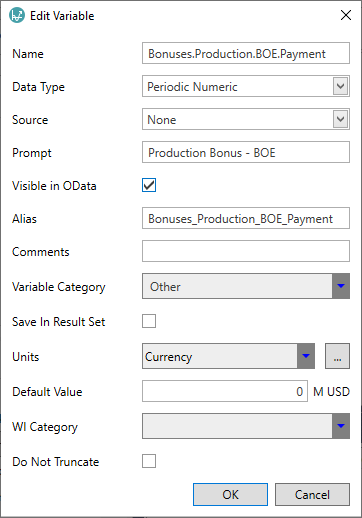
The input fields displayed depend on the variable's data type.
Variable Edit window
To edit multiple variables, click the Edit Variables button on the ribbon to open the Variable Edit window. This is a non-modal window and can be kept open while you are working on something else.

Attribute cells will be grayed out (i.e., unused) depending on the variable's data type.
Column-based filtering
For version 16.5 Update 32 and later:
The table columns in the Variable Edit window have filter tools available.
If you click a filter button  in a column header, a filter dialog will be
displayed. Here you can set up filters to show variables which match particular criteria. To remove a column filter,
re-open its dialog and click Clear Filter.
in a column header, a filter dialog will be
displayed. Here you can set up filters to show variables which match particular criteria. To remove a column filter,
re-open its dialog and click Clear Filter.
Full Text Search
The Variable Edit window has a Full Text Search box which can be opened by clicking anywhere in the table and typing CTRL+F. The box will appear above the table:
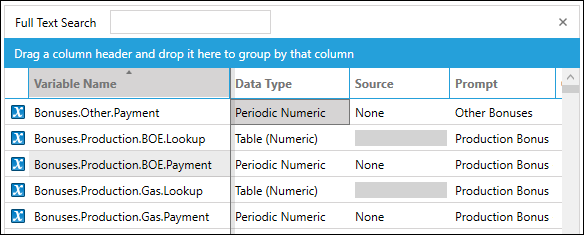
To close the search box, click the X button at the right-hand end.
You can type one or more search terms into the box, separated by spaces. The displayed list will be dynamically filtered based on the search terms, using an implicit OR operation (i.e., at least one out of multiple terms must match); the terms are matched with any text found in the columns Variable Name, Prompt, Comments, Variable Category, and WI Category.
To make an exact text match, put the search term in quotation marks ("other bonuses" for example).
Grouped table view
You can create a grouped table by dragging and dropping one or more column names to the blue bar Drag a column header and drop it here ... above the headers.
The list of variables will be organized in a hierarchy based on the columns selected. For example:
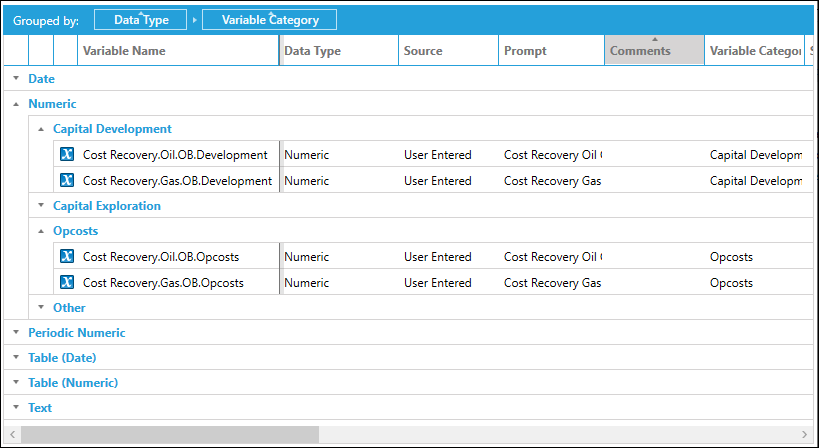
To remove the grouping, hover the mouse over a column name in the blue bar and click the X button that appears. By clicking the column name text you can toggle the list ordering between ascending and descending.
If two or more columns are selected for grouping, you can change the hierarchy ordering by dragging a column name left or right within the blue bar.
Data types
The following table describes the available data types.
| Type | Description |
|---|---|
| Numeric | A scalar 'float' (single precision) value used for holding any numerical result. This is also used for integers because there is no specific integer data type. |
| Text | A text or 'string' value. These can have enumerations as part of the definition, which can be used to restrict the allowed values. |
| Date | A Date variable in Economics is defined as 'YearMonth' since monthly is the most-granular periodicity possible. |
| Periodic Numeric | This is the same as Numeric except that it is an array of values covering the date range of the project (or consolidation). The periodicity is always monthly. |
| Table (Numeric) | A lookup table where the Lookup column (left-hand) is Numeric values and the Result column (right-hand) is also Numeric. This means that both the argument and output are Numeric. |
| Table (Date) | A lookup table where the lookup column (left-hand) is Date values and the Result column (right-hand) is Numeric. This means that the argument must be a Date and the output is Numeric. |
Lookup Table (Numeric) variables are typically represented in tabular form. A typical table might look like this, with any number of rows.
| Lookup | Result |
|---|---|
| 1,000 | 25% |
| 5,000 | 30% |
| 8,000 | 32% |
Lookup Table (Date) variables are typically represented in tabular form. A typical table might look like this, with any number of rows.
| Lookup | Result |
|---|---|
| 01/2014 | 25% |
| 05/2020 | 30% |
| 01/2100 | 32% |
Variable attributes
The following table describes the attributes as they appear in both the Edit Variable and Variable Edit windows.
| Column | Description |
|---|---|
| Variable Name | Variable name in the Dot Notation format. Note that variables cannot be renamed and names must be unique. |
| Data Type | Variable types are explained in the table below. |
| Source | Specify if it is an Input (a project input where the user should enter a value), a Term (contract Terms, that is fiscal regime settings) or None (a value calculated in the module). |
| Prompt | User-friendly variable name displayed in headers in project and report templates, and terms. |
| Comments | Plain text string for comments. |
| Variable Category | The group to which the variable belongs; these categories are used for sensitivities. Type a new category or select one from the list. |
| Save in Result Set | Specifies whether the variable is stored after a result set calculation. |
| Default Value | Default variable value. Most numerical values will default to zero but some, such as a tax rate, might need a different default value. Any new project will have this value automatically populated. Also note that if the Source is set to None then the variable will have the default value unless it is otherwise set via the calculation logic. |
| Units | Type of unit that defines the variable (see Units of measurement). The units are important as they define many aspects of the behavior such as Imperial/Metric conversion, display strings, aggregation methods etc. |
| WI Category | Specifies which working interest category the variable applies to. Type a new value or select an existing one from the list. This setting is optional. For input variables, the system will determine the working interest share of Net based on the category specified here. |
| Do Not Truncate | Applies to Periodic Numeric variables. If disabled, variable values will be truncated after the economic limit. Most array values are truncated at the economic limit. Checking this option means that the values will not be truncated which is often useful for prices, tax rates, etc. |
| Aggregation Method | Applies to Date and Text variables. Specifies what happens when the variable is aggregated. For numeric variables this will be derived from the units. Text variables don’t have units so it does not need to be specified. |
| Enum List Type |
Applies to Text variables. Variables can be open, i.e. the user can enter any value. Alternatively, the allowed values can be restricted to an enumerated list. The options for this setting are:
|
| Enum List | Enter the list of allowed values here if Custom is selected above. |
| Lookup Prompt | For Table variables: the title of the left column. |
| Lookup Units | For Table variables: units of measurement for the left column. |
| Result Prompt | For Table variables: the title of the right column. |
| Result Units | For Table variables: units of measurement for the right column. |
| Visible In OData | Checkbox to specify if the variable should be visible for queries made through the OData API. |
| Alias | This is the variable's alias which is used to reference it in OData API requests based on the 'Tall' and 'Wide' tables. If the variable is set as not visible in OData then the Alias can be blank. If the variable is set as visible then it must have a value. A default value will be assigned based on the variable's Name. (See further details in the 'Variable Alias' section below.) |
Variable Alias
The Alias value is used as the variable reference in OData API requests involving the 'Tall' and 'Wide' data tables. The Alias must be unique and the first letter must be in upper case. Symbolic characters cannot be used except for underscore, and spaces cannot be used.
If the variable is set not to be used via OData (i.e., the option Visible In OData is disabled) then the Alias can be blank.
If Visible In OData is set to enabled and the Alias is blank, a default value will be inserted, based on the variable's Name value with spaces and symbolic characters replaced (e.g., spaces and dots are replaced by underscores, the % symbol is replaced by 'Pct', ampersands are replaced by 'And').
The Alias value can be edited at any time. Changing the value can be useful for meaningful naming of variables as they appear to users via OData (e.g., users working in an OData client such as Power BI), and contracting the Alias so as to shorten API request strings, since there is a limit on the allowed total string length for API requests.
Variable Bulk Edit
Variables can be edited in bulk. To access this, click the Edit Variables button
 on the ribbon; the Variable Edit window will open. To apply the same setting to multiple variables,
highlight the cell you want to copy then highlight the cells below it that you want to copy the setting into.
on the ribbon; the Variable Edit window will open. To apply the same setting to multiple variables,
highlight the cell you want to copy then highlight the cells below it that you want to copy the setting into.
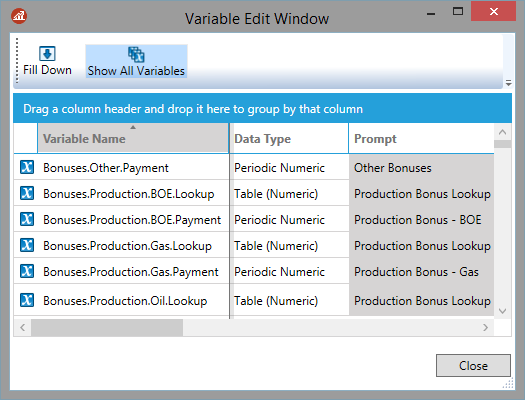
Next click the Fill Down button  . The setting will be applied to the selected variables.
. The setting will be applied to the selected variables.
Note you can change the display ordering of variables by clicking on any column heading.
Note: If you only highlight the one cell containing the setting you want to copy, when you click Fill Down the setting will be copied to all of the following cells in the column.
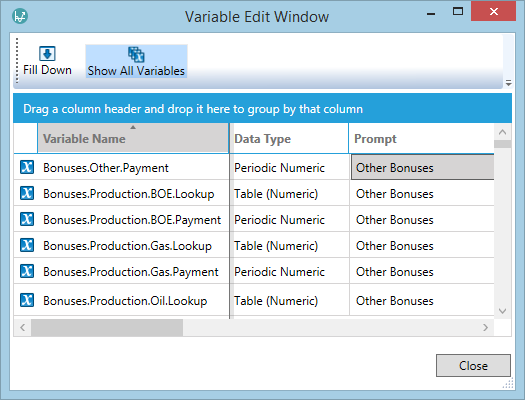
When you have finished editing, click Close to save the changes.
